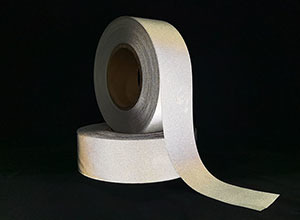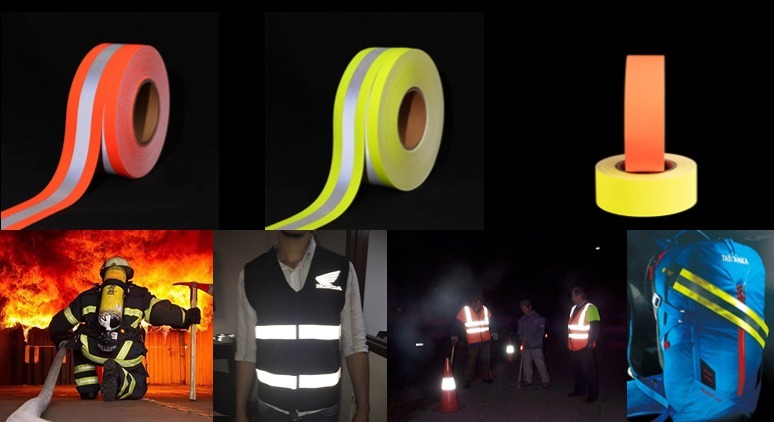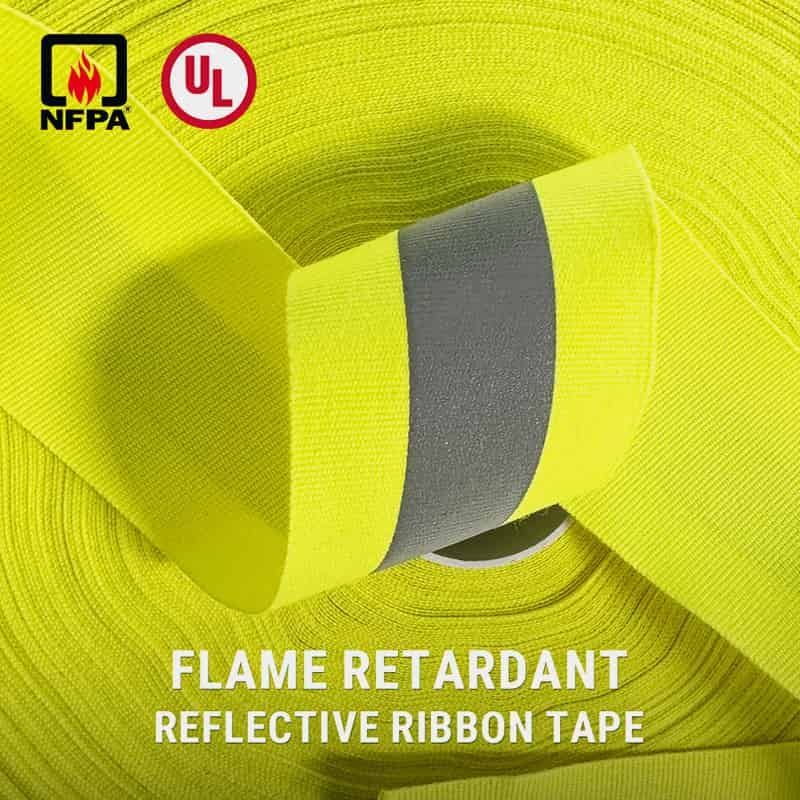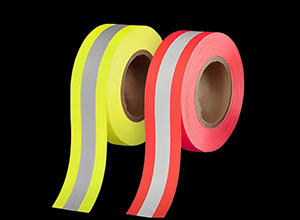Why Fabrics Are Crucial to Reflective Tape for Clothing Performance
2025-04-25
Ysmlite
ysmlite.com

Reflective tape is widely used in functional clothing such as workwear, outdoor clothing, sportswear, uniforms, etc. Its core function is to improve visibility and safety at night or in low light environments. However, many people tend to overlook a key factor-the performance of reflective tape depends not only on the reflective layer itself, but also on the bottom fabric material.
Among the reflective materials for clothing, common fabric base fabrics include cotton, aramid and T/C (polyester-cotton) blends. These materials have their own advantages in softness, flame retardancy, abrasion resistance, reflective fastness, etc., and also bring different challenges.
Cotton fabric reflective fabric tape
Cotton fabric is one of the most popular natural fibers in traditional clothing manufacturing. Reflective tape with cotton as the base fabric has good softness and breathability, especially suitable for clothing that comes into contact with the skin, such as summer workwear, sportswear, etc.
✅Advantages
- Soft to the touch, comfortable to wear, and improves the overall texture of clothing.
- It has good moisture absorption and breathability, suitable for high temperature environments.
- It combines well with reflective film and has strong processing adaptability.
⚠️Challenges
- Poor durability: cotton fibers are easy to shrink and deform, and long-term washing may cause the reflective layer to fall off or crack.
- Poor flame retardancy: It is unsafe in high temperature or fire environment, and is not suitable for professional clothing such as electric welding and fire fighting.
- It is easy to fade, affecting the overall appearance of the tape.
🛠 Suggestion: If you need to use cotton-based reflective tape, you can choose specially treated anti-shrink cotton cloth, and pay attention to the washing and care method (it is recommended to use cold water washing and avoid high temperature drying) to extend the service life.

Aramid fabric FR reflective tape
Aramid is a high-performance organic synthetic fiber, widely used in high-risk working environments such as fireproof clothing, military and police equipment. Reflective tape with aramid as the base fabric has excellent flame retardant, cut-resistant, high temperature resistant and wear-resistant properties, and is a truly professional-grade material.
✅Advantages
- Naturally flame retardant, no additional treatment required, no melting droplets when the flame burns.
- High temperature resistance of more than 400°C, suitable for high heat source working scenes.
- Strong tear resistance and wear resistance, longer service life in harsh environments.
- Good chemical stability, not easy to age.
⚠️Challenges
- Expensive: high material cost and complex processing requirements.
- Relatively poor softness, not as comfortable to wear as cotton or T/C.
- Few color options, industrial appearance.
📌 Tips: When choosing aramid reflective tape, it is recommended to confirm that it has passed the international flame retardant standard certification such as EN ISO 11612 or NFPA 2112 to ensure that it truly reaches the flame retardant safety level.

T/C blended fabric reflective tape for clothing
T/C (polyester-cotton) blended fabric is a textile that mixes polyester (polyester) and cotton in different proportions. Common proportions are 65/35, 80/20, etc. This type of fabric has a balanced performance in terms of strength, stability, cost-effectiveness and appearance, and is currently a very mainstream reflective tape base fabric in the workwear market.
✅ Advantages
- More wear-resistant and wrinkle-resistant than pure cotton, and not easy to deform after washing.
- Moderate hygroscopicity, crisp appearance, and conducive to shaping.
- Moderate cost, suitable for large-scale purchases.
- Easy to dye, more styles.
⚠️ Challenges
- The flame retardant performance is average, and additional flame retardant treatment is required.
- The polyester part is easy to melt at high temperatures, which poses a safety hazard.
🧪 Recommended technology: You can choose T/C fabrics treated with Proban or Pyrovatex flame retardant technology to enhance its protective performance, which is suitable for enterprises that have dual considerations for cost and safety.

The actual impact of fabric selection on reflective performance, fastness and durability
Different fabrics not only affect the softness and appearance of reflective tapes, but also directly affect the bonding fastness, washing life and service life of its reflective film. The following is a measured comparison of key influencing factors:
| Performance indicators | Cotton cloth | Aramid cloth | T/C cloth |
| Bonding fastness (peel strength) | Medium | High | High |
| Reflective brightness (cd/lux/m²) | High | High | Medium to high |
| Water washing resistance (≥60°C) | ≤25 times | ≥50 times | 35-45 times |
| Flame retardancy | Poor | Excellent | General (needs treatment) |
| Cost | Low | High | Medium |
📌 Practical tips:
- It is recommended to choose T/C or aramid base fabrics for workwear to improve cost performance or enhance protection.
- If clothing needs to be washed frequently, reflective tapes with high-fastness structures or laser-cut edge processes are preferred.
- Using high-frequency hot pressing equipment can effectively improve the fastness between the tape and the fabric.
How to correctly choose reflective tape for clothing fabrics according to the usage scenario?
When choosing reflective tape fabrics, the most important thing is to first clarify the specific needs of the use environment, and then match the most suitable fabrics and processing technology. The main influencing factors include:
- Temperature and flame retardant requirements
- Mechanical stress (stretching, abrasion, tearing, etc.)
- Washing frequency and chemical exposure
- Comfort and breathability
- Cost and batch requirements
- Certification and regulatory standards
Engineering/construction site scenes
- Environmental characteristics: dusty, muddy, occasional chemical splashes; high temperature during the day, large temperature difference at night; need to be worn for a long time.
- Key requirements: wear resistance, high fastness, basic flame retardancy, and resistance to multiple industrial washings.
- Recommended fabrics and treatments:
- 65/35 T/C (polyester-cotton) treated with Proban/Pyrovatex flame retardant process
- The proportion of polyester is not less than 35%, ensuring wear resistance and easy cleaning
- Laser cutting + ultrasonic heat sealing to prevent edge fuzzing and improve peel strength
- Operation suggestions:
- Use micro-prismatic reflective structure to maintain brightness in dusty environments.
- Use neutral detergent, ≤40 °C water temperature when washing, and reduce drying to protect the flame retardant coating.
Firefighting/high temperature operation scene
- Environmental characteristics: open flame, high temperature radiation, and risk of molten droplet splashing.
- Key requirements: natural flame retardant, high temperature resistance without molten droplet, tear resistance.
- Recommended fabrics and treatments:
- Aramid pure fabric or content ≥ 80%
- Must be certified by EN ISO 11612 (flame retardant performance of industrial protective clothing) or NFPA 2112 (fire suits)
- The adhesive backing of the reflective tape must use a high-temperature silicone adhesive with a temperature resistance of up to 250 °C
- Operation suggestions:
- Use a double-layer hot pressing process: first firmly bond the reflective film and the aramid cloth, and then cure the entire garment at high temperature.
- Regularly check the peel strength of the reflective strip (recommended 50 N/25 mm or more) to ensure long-term use without the risk of degumming.
Sports/outdoor/cycling clothing scenarios
- Environmental characteristics: long-term high-intensity exercise, a lot of sweat, need to be light and breathable, and maintain high visibility under low light conditions at night.
- Key requirements: light, breathable, sweat-resistant, and high brightness.
- Recommended fabrics and treatments:
- 100% cotton or thin T/C (80/20)
- It is recommended to use nano-micro prismatic film for reflective film to ensure that the reflectivity is ≥300 cd/lux/m² under low illumination
- The adhesive and fabric joints can be grid embossed to reduce weight and improve breathability
- Operation suggestions:
- The width of the reflective strip is best between 10–20 mm, which does not affect the stretching of the clothes and can ensure sufficient reflective area.
- When washing, machine wash on the reverse side and tumble at low speed to avoid excessive stretching and damage.
Logistics/transportation uniform scene
- Environmental characteristics: all-weather indoor and outdoor switching, multiple wearing and taking off, bending and washing; need to remain eye-catching and durable.
- Key requirements: high brightness, washable, easy to maintain, and cost controllable.
- Recommended fabrics and treatments:
- 65/35 T/C or 50/50 T/C, which is conducive to printing and dyeing and post-processing
- The surface can be PU coated or anti-fouling finished to facilitate the cleaning of oil stains and stains
- It is recommended to choose a glass bead reflective structure for reflective tape, which has good performance facing all-weather light sources
- Operation suggestions:
- Double needle lock edge can be added to the decorative seams to prevent the edges from curling during washing.
- It is recommended to uniformly adopt an integrated design of washing labels and rubber strips to reduce stitching points and improve overall fastness.
Chemical/petrochemical/heavy industry scenes
- Environmental characteristics: chemical corrosion, high temperature steam, grease and acid-base media.
- Key requirements: chemical corrosion resistance, high temperature resistance, easy cleaning, and high fastness.
- Recommended fabrics and treatments:
- Aramid blends or high-density T/C (can be flame-retardant and chemical-resistant)
- The adhesive backing of the reflective tape needs to be made of chemical-resistant hot melt adhesive
- Operation suggestions:
- Three anti-coatings (waterproof, oil-proof, and chemical-resistant) can be added to the seams and heat seals
- Regularly perform steam accelerated aging tests to verify the reflective performance and fastness changes.
Medical/sanitation/food processing scenarios
- Environmental characteristics: need to be kept clean, resistant to multiple disinfections, and skin-friendly.
- Key requirements: hypoallergenic, easy to clean, resistant to medical disinfectants, and moderately reflective.
- Recommended fabrics and treatments:
- 100% cotton or medical-grade T/C (50/50)
- The reflective tape uses food-grade silicone adhesive to ensure no irritation when in contact with the skin
- The surface can be treated with antibacterial finishing to inhibit bacterial growth
- Operation suggestions:
- Avoid using formaldehyde-containing finishing agents to reduce the risk of skin allergies.
- When disinfecting, ultraviolet rays or alcohol spray should be used first to reduce the loss of the reflective layer by high-temperature steam.
Children/skin-friendly clothing scene
- Environmental characteristics: delicate skin, intense activities, frequent daily washing; high safety and comfort are required.
- Key requirements: ultra-soft, highly breathable, non-irritating, and sufficiently reflective.
- Recommended fabrics and treatments:
- 100% cotton or soft T/C (80/20)
- The backing of the reflective tape uses low-temperature curing environmentally friendly glue to ensure that it is not too hard during lamination
- Use micro-glass bead structure or ultra-thin micro-prism film to reduce thickness
- Operation suggestions:
- Try to use the overall hot pressing seamless process to reduce friction at the needle and thread seams.
- Washing is recommended to wash by hand below 40 °C and dry naturally to extend the service life.
Conclusion
The base material of the clothing reflective tape directly determines its service life, safety performance and user experience. When choosing, you should not only look at the price or brightness, but also consider:
- Safety requirements of the industry
- Comfort and mobility of the wearer
- Frequency of use and washing method of the product
- Long-term maintenance cost and brand image
As a professional reflective material manufacturer, YSM has rich experience in base fabric matching and customization capabilities. It can provide customers with multi-material reflective tape solutions from cotton, aramid, T/C to high-performance flame-retardant webbing, and supports small batch proofing and OEM/ODM services.
If you still have questions about which fabric to choose, please contact us. We are willing to be your most trusted technical partner in the field of reflective tapes.
Related News
What Does It Mean That FR Reflective Tape Has Passed NFPA2112 and NFPA1971 Certification?
2025-06-11
Top 5 FR Reflective Tape Manufacturers in Europe
2025-06-10
Common Problems and Solutions When Using Reflective Webbing Tape
2025-06-09





